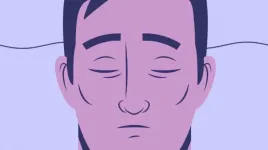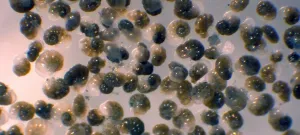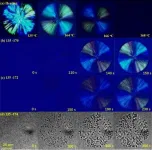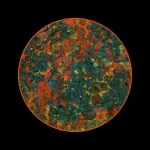'Rescue mutations' that suppress harmful DNA changes could shed light on genetic disorders
2021-05-27
(Press-News.org) New insights into the ability of DNA to overcome harmful genetic changes have been discovered by scientists at the Wellcome Sanger Institute, the University of Lausanne and their collaborators. The team found that 26 per cent of harmful mutations were suppressed by naturally occurring variants in at least one wild yeast strain. In each instance examined in detail, a single 'rescue mutation' was responsible for cancelling out another mutation that would have threatened the organism's survival.
The study, published today (27 May 2021) in Molecular Systems Biology, provides important information about how DNA variants can suppress undesirable genetic changes. If confirmed in humans, this biological phenomenon could have an important role in genetic diseases such as cancer or rare developmental disorders, and explain why certain patients suffer from more severe disease than others.
Mutations are changes to the letters of DNA that form the genetic code of multi-cellular organisms. They can be a result of errors when DNA replicates during cell division, or the influence of environmental exposures such as ultraviolet light. While most mutations will have no significant effect on how the cell functions, some can be harmful and lead to genetic diseases such as cancer. Other mutations can be beneficial and contribute to genetic diversity in a species through the natural process of evolution1.
With six billion letters of DNA in the human genome, the implications of natural genetic variation are vast. As a result, the precise effect of mutations on the function of genes and cells is not fully understood. Mutations that are harmful in one individual may have no negative effect on another. In some cases, this is because the healthy or resilient individuals carry additional mutations, called suppressors, which counteract harmful DNA changes.
In this study, researchers at the University of Toronto screened 1,106 temperature-sensitive alleles2 from 580 essential genes3 in 10 wild yeast strains to see if natural genetic variation would allow the yeast to grow when exposed to an unfavourably high temperature.
They found that 26 per cent of the 580 essential genes could be circumvented by natural variants in at least one wild yeast strain. Yeast colonies that continued to grow were then sequenced at the Wellcome Sanger Institute, in order to search for specific mutations that could be suppressing the temperature-sensitive allele.
Professor Jolanda van Leeuwen, a senior author of the paper from the University of Lausanne, said: "The proportion of harmful mutations in essential genes that could be supressed was unexpected, and because we only sampled a small fraction of wild yeast strains the percentage of mutations that can be suppressed by natural variants is likely to be much higher. The frequency of suppression suggests it could make an important contribution in other contexts as well - including, potentially, for human disease."
Researchers at the University of Lausanne examined 10 instances of suppression in detail to better understand the suppression effect and how it protected cells. To their surprise, in each case a single mutation was responsible for suppressing the temperature-sensitive allele and enabling cells to live and reproduce.
Dr Leopold Parts, a senior author of the paper from the Wellcome Sanger Institute, said: "In biology, explanations tend to be complex, so it's unusual to find a single 'smoking gun'. We might have expected a number of genes to combine to overcome a serious genetic defect like the temperature-sensitive allele, so for this to be the result of a single mutation is very surprising."
Work is already underway at the Sanger Institute to conduct a similar study in human cells to see how relevant these findings are to the human genome, using commercially available human cell lines from healthy donors. If the same biological phenomenon is at play, it could provide valuable information about how genetic diseases arise and whether 'rescue mutations' might one day help clinicians to treat these diseases.
INFORMATION:
Contact details:
Dr Matthew Midgley
Press Office
Wellcome Sanger Institute
Cambridge, CB10 1SA
Phone: 01223 494856
Email: press.office@sanger.ac.uk
Notes to Editors:
1 For an overview of genetic mutations, see yourgenome.org
2 An allele is a variant form of the same gene. The combination of alleles influences an individual's physical traits, such as eye colour. For more information, see yourgenome.org
3 Essential genes are those that are absolutely required for the cell to live and reproduce.
Publication:
Leopold Parts, Amandine Batté and Maykel Lopes et al. (2021). Natural variants suppress mutations in hundreds of essential genes. Molecular Systems Biology. DOI: https://doi.org/10.15252/msb.202010138
Funding:
This work was supported by Wellcome, the Swiss National Science Foundation and the Foundation for Medical Research.
Selected websites:
University of Lausanne (UNIL)
Founded in 1537, the University of Lausanne now has seven faculties and stands out as an interdisciplinary, sustainable institution that caters for more than 17,000 students and 4,500 staff. UNIL's primary focus is on the humanities and social sciences, life sciences (biology and medicine) and environmental science. Find out more at http://www.unil.ch.
The Wellcome Sanger Institute
The Wellcome Sanger Institute is a world leading genomics research centre. We undertake large-scale research that forms the foundations of knowledge in biology and medicine. We are open and collaborative; our data, results, tools and technologies are shared across the globe to advance science. Our ambition is vast - we take on projects that are not possible anywhere else. We use the power of genome sequencing to understand and harness the information in DNA. Funded by Wellcome, we have the freedom and support to push the boundaries of genomics. Our findings are used to improve health and to understand life on Earth. Find out more at http://www.sanger.ac.uk or follow us on Twitter, Facebook, LinkedIn and on our Blog.
About Wellcome
Wellcome supports science to solve the urgent health challenges facing everyone. We support discovery research into life, health and wellbeing, and we're taking on three worldwide health challenges: mental health, global heating and infectious diseases. https://wellcome.org/
ELSE PRESS RELEASES FROM THIS DATE:
2021-05-27
Millions of surgical procedures performed each year would not be possible without the aid of general anesthesia, the miraculous medical ability to turn off consciousness in a reversible and controllable way.
Researchers are using this powerful tool to better understand how the brain reconstitutes consciousness and cognition after disruptions caused by sleep, medical procedures requiring anesthesia, and neurological dysfunctions such as coma.
In a new study published in the journal eLife, a team led by anesthesiologists George Mashour, M.D., Ph.D. of University of Michigan Medical School, Michigan Medicine, Max Kelz, M.D., Ph.D. of the University of Pennsylvania Medical School, and Michael Avidan, MBBCh ...
2021-05-27
This striking image showcases the unusually contorted appearance of NGC 2276, an appearance caused by two different astrophysical interactions -- one with the superheated gas pervading galaxy clusters, and one with a nearby galactic neighbour.
The interaction of NGC 2276 with the intracluster medium -- the superheated gas lying between the galaxies in galaxy clusters -- has ignited a burst of star formation along one edge of the galaxy. This wave of star formation is visible as the bright, blue-tinged glow of newly formed massive stars towards the left side of this image, and gives the galaxy a strangely lopsided appearance. NGC 2276's recent burst of star formation is also related to the appearance of more exotic inhabitants -- black holes and neutron stars ...
2021-05-27
What does quark-gluon plasma - the hot soup of elementary particles formed a few microseconds after the Big Bang - have in common with tap water? Scientists say it's the way it flows.
A new study, published today in the journal SciPost Physics, has highlighted the surprising similarities between quark-gluon plasma, the first matter thought to have filled the early Universe, and water that comes from our tap.
The ratio between the viscosity of a fluid, the measure of how runny it is, and its density, decides how it flows. Whilst both the viscosity ...
2021-05-27
Woods Hole, Mass. (May 27, 2021) - With the expansion of oxygen-depleted waters in the oceans due to climate change, some species of foraminifera (forams, a type of protist or single-celled eukaryote) that thrive in those conditions could be big winners, biologically speaking.
A new paper that examines two foram species found that they demonstrated great metabolic versatility to flourish in hypoxic and anoxic sediments where there is little or no dissolved oxygen, inferring that the forams' contribution to the marine ecosystem will increase with the expansion of oxygen-depleted habitats.
In addition, the paper ...
2021-05-27
Twenty scientists from 14 countries warn of a hidden "pandemic within the pandemic" in two current publications. On the one hand, physical activity levels have gone down significantly, on the other hand, psychological well-being has suffered. "Governments and those responsible for health systems should take our findings seriously," emphasizes the author team, headed by Dr Jan Wilke from the Institute for Sport Sciences at Goethe University Frankfurt.
About 15,000 people in participating countries answered standardised questionaires as part of an international survey. In April/May 2020, they reported physical activity levels (13,500 participants) as well as their mental and physical well-being (15,000 participants) ...
2021-05-27
With global warming decreasing the size of New Zealand's alpine zone, a University of Otago study found out what this means for our altitude-loving kea.
The study, published in Molecular Ecology, analysed whole genome DNA data of the kea and, for the first time, its forest-adapted sister species, the kākā, to identify genomic differences which cause their habitat specialisations.
The researchers found the kea is not an alpine specialist, but rather one that adapted to using such an open habitat because it was least disturbed by human activity.
Co-author Associate Professor Michael Knapp, of the Department of Anatomy, says that is not likely to surprise people ...
2021-05-27
Different from small molecules, polymer will fold into lamellar crystals during crystallization and further assemble into lamellar stacks.
Synchrotron Small-Angle X-Ray Scattering (SAXS) is an important tool to characterize such nanoscale structure and understand polymer crystallization. However, its scattering mechanism in semi-crystalline polymers is not completely elucidated yet.
Recently, a research group led by Prof. TIAN Xingyou from Institute of Solid State Physics, Hefei Institutes of Physical Science (HFIPS), proposed a complete set of new methods to characterize polymer lamellar crystals ...
2021-05-27
Epithelial ovarian cancer (EOC) is the most common lethal gynaecological cancer. Ovarian cancer is usually treated with platinum-based chemotherapy; however, a significant number of patients are resistant to such treatments and relapse soon afterwards. To improve their survival, there is a need to first identify which patients may be platinum-resistant, so that newer treatments may be administered early.
Now, researchers from the Cancer Science Institute of Singapore (CSI Singapore) at the National University of Singapore (NUS), have discovered a way to predict which patients are resistant to platinum chemotherapy. The study, co-led by CSI Singapore Principal ...
2021-05-27
Current best practices for encouraging more female students to pursue degrees in economics may actually have the opposite effect and worsen gender disparities in the field, a recent study from Oregon State University found.
The study examined whether mass emails telling introductory economic students about promising career and earning opportunities helped increase female participation in higher-level economics courses. But instead, these emails appealed more to male students, increasing male enrollment and widening the existing gender gap. There was no change in the probability of female students majoring in economics.
Researchers say this demonstrates a need for more personalized, deliberate interventions.
"There ...
2021-05-27
Using renewable energy to replace fossil energy is now considered the best solution for greenhouse gas emission and air pollution problems. As a result, the demand for new and better energy storage technology is strong.
As part of the effort to improve this technology, a group led by Prof. ZHANG Suojiang from the Institute of Process Engineering (IPE) of the Chinese Academy of Sciences (CAS) recently found that ionophobic electrodes can boost energy storage performance.
Their study was published in the Journal of Materials Chemistry A on May 8.
Electric Double-Layer Capacitors (EDLCs) with ionic liquids (ILs)--as a new type of energy storage device--can fill the gap between the power density of batteries and the ...
LAST 30 PRESS RELEASES:
[Press-News.org] 'Rescue mutations' that suppress harmful DNA changes could shed light on genetic disorders





